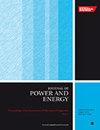基于改进颗粒运动与沉积模型的烟气轮机催化剂颗粒沉积特性数值分析
IF 1.1
4区 工程技术
Q3 ENGINEERING, MECHANICAL
Proceedings of the Institution of Mechanical Engineers, Part A: Journal of Power and Energy
Pub Date : 2023-07-10
DOI:10.1177/09576509231188183
引用次数: 0
摘要
为了更准确地了解和预测烟气轮机叶栅中催化剂颗粒的沉积行为,本文进行了试验与数值相结合的研究。在系统分析催化剂颗粒沉积过程和物理机理的基础上,采用用户自定义函数自定义函数对传统的DRW模型、临界速度颗粒沉积模型和去除模型进行修正,并用实际沉积形貌进行验证。在此基础上,详细研究了颗粒斯托克斯数和烟气参数对烟气涡轮叶栅颗粒沉积特性的影响。结果表明,修正后的DRW模型、临界速度和去除模型能更准确地预测颗粒在涡轮叶栅中的沉积位置和沉积速率。随着颗粒Stokes数的增加,颗粒对叶片表面的平均撞击率逐渐增大,平均沉积率呈现先增大后减小的趋势。颗粒在动叶表面的平均沉积速率大约是静叶表面的两倍。随着烟气膨胀比的增大,小于3 μm颗粒的沉积速率逐渐增大,大于3 μm颗粒的沉积速率有减小的趋势。此外,烟气膨胀比的变化对不同粒径范围内颗粒沉积分布无明显影响。本文章由计算机程序翻译,如有差异,请以英文原文为准。
Numerical analysis of catalyst particle deposition characteristics in a flue gas turbine with an improved particle motion and deposition model
To more accurately understand and predict the deposition behavior of catalyst particles in the flue gas turbine cascade, test and numerical combined study is performed in this paper. Based on the systematic analysis of the deposition process and physical mechanism of the catalyst particles, the traditional DRW model, critical velocity particle deposition model and removal model were corrected with the user defined function custom function and validated with the actual deposition morphology. On this basis, the effects of the particle Stokes number and flue gas parameters on the particle deposition characteristics of the flue gas turbine cascade were detailed investigated. The results show that the revised DRW model, critical velocity and removal model can more accurately predict the deposition location and deposition rate of particles in the turbine cascade. With the increase in the Stokes number of particles, the average particle impact rate on the blade surface gradually increased, while the average deposition rate showed a trend of first increasing and then decreasing. The average deposition rate of particles in the rotor blade surface is roughly twice as high as that in the stator surface. With the increase of the flue gas expansion ratio, the deposition rate of particles less than 3 μm gradually increases, while the deposition rate of particles greater than 3 μm tends to decrease. In addition, the change in the flue gas expansion ratio has no obvious effect on the particle deposition distribution in different size ranges.
求助全文
通过发布文献求助,成功后即可免费获取论文全文。
去求助
来源期刊

CiteScore
3.30
自引率
5.90%
发文量
114
审稿时长
5.4 months
期刊介绍:
The Journal of Power and Energy, Part A of the Proceedings of the Institution of Mechanical Engineers, is dedicated to publishing peer-reviewed papers of high scientific quality on all aspects of the technology of energy conversion systems.
 求助内容:
求助内容: 应助结果提醒方式:
应助结果提醒方式:


